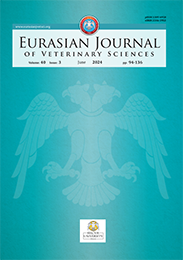| 2014, Cilt 30, Sayı 3, Sayfa(lar) 145-151 |
| [ Türkçe Özet ] [ PDF ] [ Benzer Makaleler ] |
| Investigation of PrP locus polymorphisms in some native Turkish sheep breeds |
| Ercan Kurar1,3, Zafer Bulut2, Mehmet Nizamlıoğlu2 |
| 1Genetik Anabilim Dalı, Selçuk Üniversitesi, Veteriner Fakültesi, Konya, Türkiye 2Biyokimya Anabilim Dalı, Selçuk Üniversitesi, Veteriner Fakültesi, Konya, Türkiye 3Necmettin Erbakan Üniversitesi, Meram Tıp Fakültesi, Tıbbi Biyoloji Anabilim Dalı, Konya, Türkiye |
| Keywords: Sheep, scrapie, PrP, polymorphism |
| Downloaded:2051 - Viewed: 3049 |
|
Aim: The objective of this study was to investigate polymorphisms
in codons 136, 154 and 171 of the PrP gene in native
sheep breeds of Turkey.
Materials and Methods: Sampling (n=175) was conducted from Akkaraman, Guney Karaman, Kangal Akkaraman, Daglic and Awassi breeds. Genomic DNA was isolated using a standard phenol/chloroform method. PrP region was amplified by polymerase chain reaction (PCR) and allele genotypes were determined by using restriction fragment length polymorphism (RFLP) analysis. General population parameters including allel numbers (Na), observed (Ho) and expected (He) heterozygosities and deviation from Hardy-Weinberg Equilibrium (HWE) were calculated. Results: High level of A136R154Q171 genotype was observed in all populations. A136R154Q171, which is known as the most resistant genotype to scrapie, was observed at lower (0.175-0.313) frequencies. However, V136R154Q171, the most susceptible genotype to the disease, was not determined in all investigated breeds. All sheep population investigated in this study were found to be generally in R2 (resistant) and R3 (little resistant) risc categories described in National Scrapie Plan (NSP). Conclusions: It is critically important to consider PrP polymorphisms and increase frequencies of scrapie resistant genotypes in breeding of these breeds. |
| [ Türkçe Özet ] [ PDF ] [ Benzer Makaleler ] |





